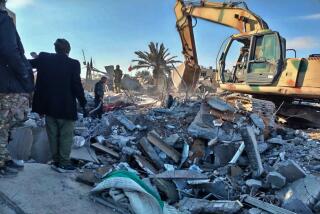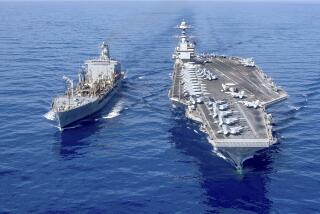Sometimes, U.S. Power Just Takes Old-Fashioned Soldiering
- Share via
The military strikes launched by the Clinton administration against Iraq seem to have achieved their minimum objective. Saddam Hussein once again was put on notice that the United States will respond when his activities threaten our interests, values or the prospects of regional security. Although similar instruction had been offered before, Saddam evidently is a slow learner.
But beyond the lessons for Saddam are major lessons for the Pentagon in this action. Since 1989, the United States has made major armed interventions in two countries, Panama and Haiti. It has engaged in two major humanitarian missions, Somalia and Rwanda. It has fought a major regional conflict, Desert Storm. It has undertaken a major peacekeeping operation, Bosnia. And it has acted three times to maintain stability in the Gulf--by striking Baghdad in June 1993 after evidence emerged of Iraqi involvement in a plot to assassinate former President Bush, by deploying Army forces to deter another threatened invasion of Kuwait in late 1994 and by this summer’s action stimulated by the Kurdish situation in northern Iraq.
In these actions, certain military capabilities have been quite useful, while others have played a more modest role. In Panama, Haiti and Somalia, the principal instrument of American power was its light infantry divisions. Secretary of State Warren Christopher noted that despite the threat of air and naval attack, it was only when the Army’s 82nd Airborne Division was en route to Haiti that the government of Gen. Raoul Cedras stepped aside, permitting the restoration of Haitian President Jean-Bertrand Aristide.
In Desert Storm, the key military capabilities that forced the Iraqi withdrawal from Kuwait were Army and Marine heavy divisions supported by tactical air forces. Desert Storm also established the enormously increased importance of both Air Force and Navy strategic mobility forces as well as theater missile defenses. But when assessed with absolute objectivity, the decisive capability was provided by the ground components. The bottom line remains that despite 37 days of furious air bombardment, it still took the land campaign to eject Iraqi forces from Kuwait. In Bosnia, the peacekeeping operation ultimately rests on the shoulders of the Army’s 1st Armored Division.
Globally, the messiness of the current strategic environment is likely to be the dominant characteristic of the future strategic environment. This is particularly true of those second- and third-tier states that have yet to reach political stability and economic vitality. Given the composition of other nations’ armed forces, it seems evident that we need to retain ready, highly capable, strategically mobile and to some degree forward deployed ground forces. Tactical air forces capable of securing local and regional air superiority also will be required, and strategic airlift and sealift will be indispensable. But as we saw in Iraq in 1991 and may be seeing once again, only ground forces can provide decisive results. In the first debate, President Clinton noted that ground troops were “the only way” to evict Saddam from northern Iraq.
Clearly, the introduction of ground forces is not always strategically or tactically appropriate. But where important American interests are involved and decisive results are required, Army and Marine forces can execute both large and small missions with minimal casualties. In the absence of either important interests or fully developed objectives, the clear preference is for longer-ranged precision munitions. Because the potential for diplomatic and emotional blackmail is so high should pilots be lost or captured, the attractiveness of manned aircraft for many traditional missions has declined. This is particularly true for carrier-based air, which is increasingly cost-ineffective compared with sea-based precision weapons.
In the emerging strategic environment, we can expect that there will be expanding demands for specialized service units providing fresh water, medical treatment, light and heavy engineering capability, local security (military police) and local order (civil affairs). And depending on the future success and direction of strategic arms negotiations and compliance, nuclear deterrent forces, particularly those that are sea-based, will continue to play a vital role. But in those regions of the world where conflict is most likely, the likely combatants have neither advanced air forces nor any significant naval capabilities. They do have, however--as Iraq continues to demonstrate--large ground formations capable of changing the local dynamics and balance of power.
All of this suggests that the currently projected defense program, which is heavily weighted toward very expensive manned aircraft and the procurement of large, carrier-based naval forces, needs to be reconsidered.


